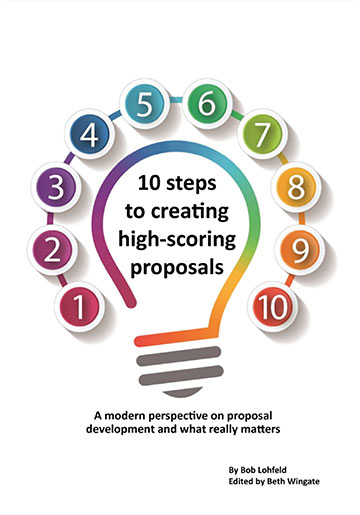How to Describe Innovation in Proposals

Make no mistake: The government is looking to government contractors to deliver innovations that will increase mission readiness, decrease costs, and support its new initiatives. For example, Executive Order 14179, Removing Barriers to American Leadership in Artificial Intelligence,aims to promote U.S. leadership in AI development. Government evaluators frequently score innovations in proposals as strengths if they benefit operations and offer an acceptable level of risk at a competitive price point. Given that fact, what constitutes an innovation, how do you describe it, how do you depict it, and what makes customers believe it might benefit them?
What Constitutes a Proposal Innovation
Innovation is something new that delivers meaningful value to a customer. It introduces a new product, method, or way of thinking to solve customer requirements and challenges. Innovations must deliver measurable benefits, and customers should be able to validate the benefits using objective data. Innovations will only be scored as strengths if they are within the customer’s risk tolerance, budget tolerance, and schedule.
One misconception about innovations is that they are limited to technological innovations, such as new applications, systems, or tools that create new capabilities, solve problems, or enhance performance. However, innovations span many genres, including those listed in Table 1.
Table 1: Ten Types of Innovations to Propose
| No. | Innovation Type | Description |
| 1 | Customer Satisfaction | New methods for increasing customer satisfaction |
| 2 | Design | Creative approaches that improve product or service designs to make them more user-friendly, accessible, or attractive |
| 3 | Financial | Pricing, cost-control, or estimation strategies that increase value, decrease costs, or reduce risk |
| 4 | Organizational | Changes in team structures or roles that increase collaboration, accountability, or communication speed |
| 5 | Policy/Regulatory | New ways to navigate, comply with, or enforce regulatory environments |
| 6 | Process | New workflows, processes, or operational methods that increase efficiency or quality |
| 7 | Service | New or improved services that better meet customer requirements or expand capabilities |
| 8 | Social | New approaches to social services, public health, or education that meet societal challenges |
| 9 | Staffing | New ways to recruit, deploy, or retain staff and new staffing methods that increase reliability, efficiency, or redundancy and surge capabilities |
| 10 | Sustainability | Solutions that reduce environmental impact, support energy efficiency, or promote sustainability |
How to Describe an Innovation in a Proposal
Introduce an innovation by outlining the need, problem, or mission it addresses. Then, clearly and concisely explain the benefit the innovation delivers—whether it’s a new technology, process, or approach—and what makes it different or better than the status quo. Next, describe how your innovation works in as much detail as possible and how your solution mitigates customer operations risk.
Use plain language and avoid jargon so evaluators can quickly grasp its value. Highlight the novel aspects of the solution, focusing on how it improves speed, reduces costs, enhances quality, or lowers risk. If possible, include quantitative evidence of performance, such as cost savings, time reductions, or user satisfaction scores, to make the benefit tangible. Finally, you must substantiate the innovation’s capabilities using quantitative or qualitative proof points. Glean the proof points from past performance, industry studies, objective third-party data, or customer quotes.
Finally, the innovation should be linked directly to the customer’s evaluation criteria and mission using their own language. This builds evaluator confidence and makes it easy to assign a strength. The most persuasive descriptions are relevant, clearly communicated, supported by evidence, and tied to the customer’s success.
How to Depict an Innovation in a Proposal
Visuals are your secret weapon when depicting an innovation in your proposal. Use diagrams, flowcharts, and infographics to make complex innovations easy to understand. A before-and-after graphic can illustrate measurable improvements, while a simple architecture diagram can show how a new system or tool benefits operations.
Always state the benefit in the visual’s title or action caption. Use callout boxes, icons, or sidebars to highlight features and benefits without overwhelming the main narrative. The aim is to enable evaluators to understand the innovation’s functionality and value.
How to Convince Customers the Innovation Benefits Them
To convince customers that your innovation benefits them, you must go beyond describing it; you need to explain why it matters to them. Link the innovation directly to their mission goals, operational challenges, and evaluation criteria.
Next, provide evidence of the innovation’s value, such as quantitative results from prior implementations, pilot data, testimonials, or cost/time savings projections. If the innovation is new or untested, outline a risk mitigation strategy and explain how you’ll ensure a smooth rollout. Most importantly, the innovation should be framed in terms of outcomes the customer cares about—increased readiness, faster service delivery, reduced burden, improved user experience, or measurable return on investment.
Conclusion
Innovations can be powerful differentiators in competitive proposals when clearly defined, convincingly described, and backed by evidence. Whether you’re proposing a new technology, a smarter process, or a novel staffing approach, your innovation must directly support the customer’s mission, offer measurable benefits, and fit within their risk and budget tolerance. By framing your innovation in customer-centric terms, depicting it with clarity, and proving its value with objective data, you give evaluators the confidence they need to score your solution as a strength.
Contact us if you would like to discuss how to frame your innovation.
Relevant Information
By Brenda Crist, Vice President at Lohfeld Consulting Group, MPA, CPP APMP Fellow
Lohfeld Consulting Group has proven results specializing in helping companies create winning captures and proposals. As the premier capture and proposal services consulting firm focused exclusively on government markets, we provide expert assistance to government contractors in Capture Planning and Strategy, Proposal Management and Writing, Capture and Proposal Process and Infrastructure, and Training. In the last 3 years, we’ve supported over 550 proposals winning more than $170B for our clients—including the Top 10 government contractors. Lohfeld Consulting Group is your “go-to” capture and proposal source! Start winning by contacting us at www.lohfeldconsulting.com and join us on LinkedIn, Facebook, and YouTube(TM).
Paperback or Kindle
10 steps to creating high-scoring proposals
by Bob Lohfeld
contributors Edited by Beth Wingate
Subscribe to our free ebrief
Teaming friends, frenemies, and enemies—12 tips to mitigate harmful effects
Did you know that contracting officers spend up to 20% of their time mitigating disputes between teaming partners? In an informal poll we conducted on LinkedIn last month, 40% of respondents classified their teaming partners as “frenemies” on their last bid.
Explore Further
- Advice (539)
- AI (28)
- APMP (18)
- Army MAPS Contracts (3)
- Business Development (294)
- Capture Management (266)
- Complex Technology Grants Services (26)
- Favorite Books (5)
- GenAI (4)
- Go-to-Market (27)
- Graphics (5)
- Lohfeld Books (2)
- NASA SEWP VI Contracts (2)
- Navy SeaPort-NxG Contracts (2)
- NIST MSE Grants (1)
- NIST NAPMP Grants (2)
- Past Performance (63)
- Post-submission Phase (14)
- Pre-RFP Preparation (264)
- Proposal Management (339)
- Proposal Production (75)
- Proposal Reviews (38)
- Proposal Writing (107)
- Pursuit Phase (108)
- Research Report (4)
- Resources (63)
- Tools & Tips (421)
- Training (13)
- Uncategorized (223)

Sign Up for INSIGHTS and Download your FREE book
We'd love to help you with your proposals. Enjoy our complimentary Lohfeld Consulting Group Capture & Proposal Insights & Tips book with your FREE subscription to our Insights Newsletter.
GET YOUR FREE BOOK



